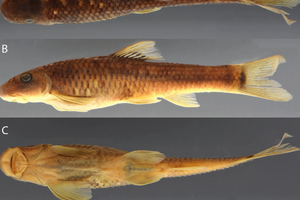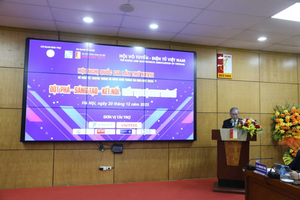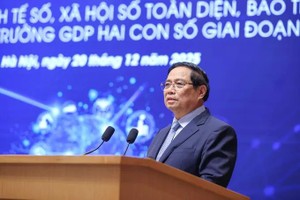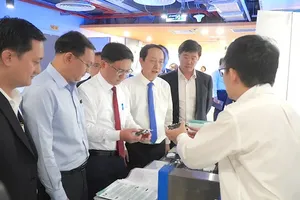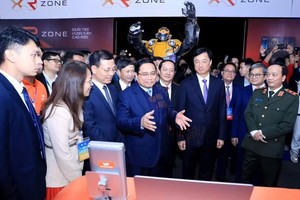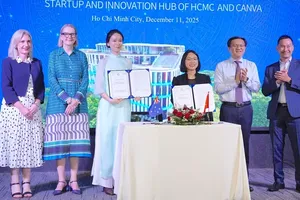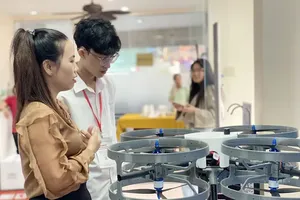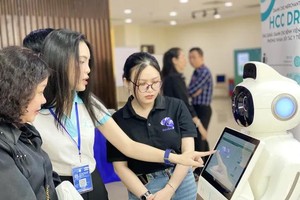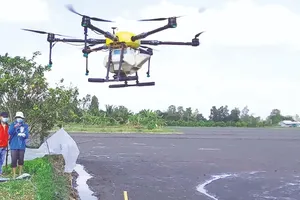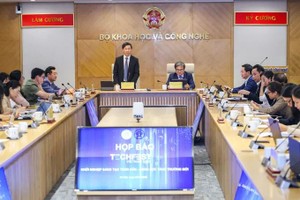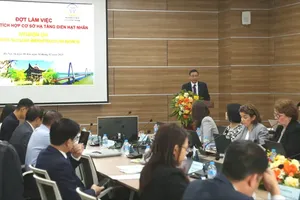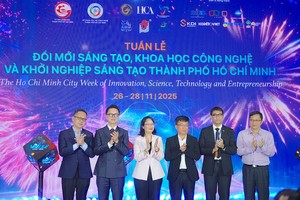Electronic transactions and online payments in Ho Chi Minh City are gradually becoming popular; even those who previously did not know about technology have now had to get used to it. This achievement is gained thanks to the digital transformation process of enterprises and business households.
 A customer scans QR to pay for petrol
A customer scans QR to pay for petrol
After delivering the cake and the box of sticky rice to the customer, Ms. Nguyen Thi Van, the owner of a bakery on Nguyen Thuong Hien Street in District 3 was waiting for the customer to pay by scanning the QR code right on the counter. The owner revealed that her shop has applied the new payment method for more than two months adding that the online payment proves to be convenient. According to Ms. Van, bank staff came to ask her to open an account, and they put a small sign with a printed QR code, her name, and her account number right on the counter.
Mr. Phan Thanh Vu Hung, a delivery man, took out his phone for customers to scan the bank's QR code and pay the amount of VND 737,000. He said that he prefers the new online payment because he calculates very slowly, so just scan like this quickly. After scanning the QR code, Mr. Hung checked and saw the money in his account.
A small coffee shop or a fruit stall in busy shopping areas in the city’s downtown corners also offers several online payment methods for customers to choose from. Even small stalls in the market or outside retail stores also have payment codes for customers to choose from, in addition to the previous traditional form of cash payment.
Diversification of non-cash payment methods and displaying products to transactions in the e-commerce environment is also being implemented quite quickly by enterprises and business households. According to the survey results in the Vietnam E-commerce White Paper in 2021 which was announced by the Ministry of Industry and Trade’s Vietnam E-Commerce and Digital Economy Agency, the percentage of internet users participating in online shopping has increased from 77 percent in 2019 to 88 percent in 2020. Ms. Lan, the owner of a stall selling vermicelli, Uot cake (vietnamese steamed rice cake) and cakes asked at Tan Dinh market in District 1, said that at one point, she registered up to 6 delivery applications, so the order came continuously.
QR is also useful in the area of water supply. When coming home from work, seeing the water outage at home, Mrs. Tran Thanh Mai in Tan Phu District’s Tan Quy Ward took the phone to the corner of the house where the QR code was passed by the Tan Hoa Water Supply Company. Mrs. Mai scanned the code and saw that there was a notice of an unexpected water outage due to a broken pipe near her house. Moreover, she also read the information that water will be supplied again around 19 o'clock. From the QR code, Ms. Van and her customers in the water supply industry get all the information they need about water service without having to install an app.
Electricity and water are two sectors that Ho Chi Minh City has set targets to lead in digital transformation. The water supply sector is responsible for supplying water to more than 10 million city dwellers.
Currently, many activities such as payment of water bills via phone, internet, an electronic water supply contract, and customer care via Zalo in the water supply sector are based on technology. Water plants are also operated in the direction of modernizing equipment, management methods, technology, and environmental protection. Most of the plants are fully automated through the SCADA system with advanced water treatment technology.
The Saigon Water Supply Corporation (SAWACO) exploits about 2 million cubic meters of raw water per day, with 9 water treatment systems providing clean water for more than 10 million city dwellers.
SAWACO also owns a long-standing and large-scale water supply system. Therefore, digital transformation is a mandatory solution to improve the quality of water supply services. Specifically, SAWACO builds infrastructure systems for digital transformation such as a data center, a SAWAGIS water supply network system on a GIS platform, building a customer management application, an application of artificial intelligence in customer service, bill management, a smart water meter system and many other projects.
Meanwhile, the Ho Chi Minh City Electricity Corporation has promoted the construction of smart grids as well as promoted comprehensive digital transformation of businesses from 2020 to now. In early 2022, the corporation put into operation the second remote control center, independent and redundant from the first remote control center in accordance with international standards. At the same time, the corporation’s modern rooms at 15 affiliated power companies were put into operation, contributing to improving the capacity of power grid management and operation in the southern largest city. Up to now, the corporation has deployed the automatic operation function without operators for 100 percent of the public medium voltage grid, helping to automatically detect and handle the problem with a time taking from 1-2 minutes.
In the customer service stage, 100 percent of electricity services are solved online at level 4, cashless electricity payment is approximately 100 percent, and all customer records have been digitized. Furthermore, remote meter clocks were installed for more than 99 percent of customers, helping customers to monitor their daily electricity consumption. The Corporation also built many soft wares to apply to business management and administration, typically power supply reliability management software (OMS) - recognized as a Make-by-EVN product at the beginning of the year 2022, currently being applied to the national electricity sector.
The Tax Department of Ho Chi Minh City has digitized the reception and handling of administrative procedures. From the beginning of 2022 to now, more than 265,800 businesses have made tax declarations online and more than 235,600 businesses pay taxes electronically at the Portal of the Ministry of Finance’s General Department of Taxation.
The Tax Department of Ho Chi Minh City also deployed the Icanhan application to support taxpayers to file tax returns 24/7 and there have been so far 275,800 registered accounts with more than 504,000 declarations on the application. In addition, roughly 813,200 records have been processed through the centralized vehicle and land registration management application.
The HCMC Tax Department said that the unit continues to strengthen the application and optimize the electrification of administrative procedures comprising electronic tax payment, electronic tax declaration, electronic invoice, and electronic tax refund as well as expand electronic tax services and implement electronic personal income tax finalization.
By staff writers - Translated by Anh Quan
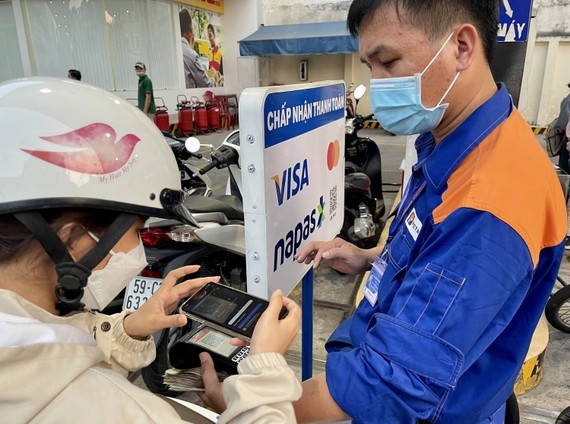 A customer scans QR to pay for petrol
A customer scans QR to pay for petrol
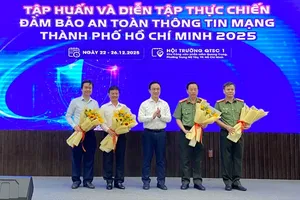
 A customer scans QR to pay for petrol
A customer scans QR to pay for petrol


